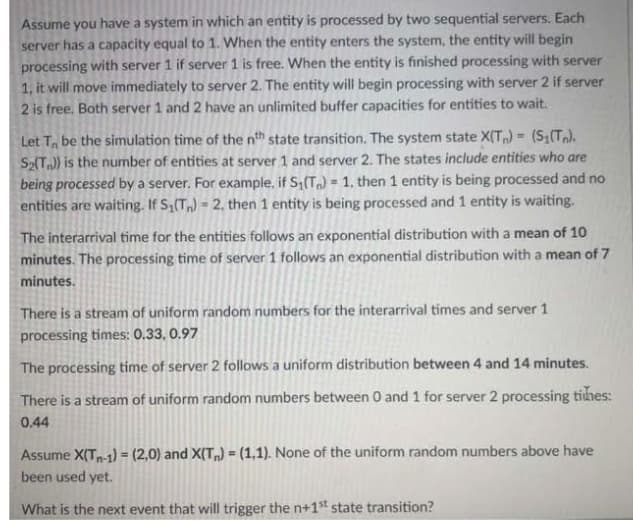Assume you have a system in which an entity is processed by two sequential servers. Each server has a capacity equal to 1. When the entity enters the system, the entity will begin processing with server 1 if server 1 is free. When the entity is finished processing with server 1, it will move immediately to server 2. The entity will begin processing with server 2 if server 2 is free. Both server 1 and 2 have an unlimited buffer capacities for entities to wait. Let T be the simulation time of the nth state transition. The system state X(T) = (S₂(T). S2(T)) is the number of entities at server 1 and server 2. The states include entities who are being processed by a server. For example, if S₁(T) = 1, then 1 entity is being processed and no entities are waiting. If S₂(Tn) = 2. then 1 entity is being processed and 1 entity is waiting. The interarrival time for the entities follows an exponential distribution with a mean of 10 minutes. The processing time of server 1 follows an exponential distribution with a mean of 7 minutes. There is a stream of uniform random numbers for the interarrival times and server 1 processing times: 0.33, 0.97 The processing time of server 2 follows a uniform distribution between 4 and 14 minutes. There is a stream of uniform random numbers between 0 and 1 for server 2 processing times: 0.44 Assume X(Tn-1)=(2,0) and X(T) = (1,1). None of the uniform random numbers above have been used yet. What is the next event that will trigger the n+1st state transition?
Assume you have a system in which an entity is processed by two sequential servers. Each server has a capacity equal to 1. When the entity enters the system, the entity will begin processing with server 1 if server 1 is free. When the entity is finished processing with server 1, it will move immediately to server 2. The entity will begin processing with server 2 if server 2 is free. Both server 1 and 2 have an unlimited buffer capacities for entities to wait. Let T be the simulation time of the nth state transition. The system state X(T) = (S₂(T). S2(T)) is the number of entities at server 1 and server 2. The states include entities who are being processed by a server. For example, if S₁(T) = 1, then 1 entity is being processed and no entities are waiting. If S₂(Tn) = 2. then 1 entity is being processed and 1 entity is waiting. The interarrival time for the entities follows an exponential distribution with a mean of 10 minutes. The processing time of server 1 follows an exponential distribution with a mean of 7 minutes. There is a stream of uniform random numbers for the interarrival times and server 1 processing times: 0.33, 0.97 The processing time of server 2 follows a uniform distribution between 4 and 14 minutes. There is a stream of uniform random numbers between 0 and 1 for server 2 processing times: 0.44 Assume X(Tn-1)=(2,0) and X(T) = (1,1). None of the uniform random numbers above have been used yet. What is the next event that will trigger the n+1st state transition?
Linear Algebra: A Modern Introduction
4th Edition
ISBN:9781285463247
Author:David Poole
Publisher:David Poole
Chapter2: Systems Of Linear Equations
Section2.4: Applications
Problem 28EQ
Related questions
Question
1

Transcribed Image Text:Assume you have a system in which an entity is processed by two sequential servers. Each
server has a capacity equal to 1. When the entity enters the system, the entity will begin
processing with server 1 if server 1 is free. When the entity is finished processing with server
1, it will move immediately to server 2. The entity will begin processing with server 2 if server
2 is free. Both server 1 and 2 have an unlimited buffer capacities for entities to wait.
Let T, be the simulation time of the nth state transition. The system state X(T) = (S(T).
S2(T)) is the number of entities at server 1 and server 2. The states include entities who are
being processed by a server. For example, if S,(T) = 1, then 1 entity is being processed and no
entities are waiting. If S,(T) = 2. then 1 entity is being processed and 1 entity is waiting.
The interarrival time for the entities follows an exponential distribution with a mean of 10
minutes. The processing time of server 1 follows an exponential distribution with a mean of 7
minutes.
There is a stream of uniform random numbers for the interarrival times and server 1
processing times: 0.33, 0.97
The processing time of server 2 follows a uniform distribution between 4 and 14 minutes.
There is a stream of uniform random numbers between 0 and 1 for server 2 processing tiuhes:
0.44
Assume X(Tn-1) = (2,0) and X(T) = (1,1). None of the uniform random numbers above have
been used yet.
What is the next event that will trigger the n+1st state transition?
Expert Solution
This question has been solved!
Explore an expertly crafted, step-by-step solution for a thorough understanding of key concepts.
Step by step
Solved in 3 steps with 35 images

Recommended textbooks for you

Linear Algebra: A Modern Introduction
Algebra
ISBN:
9781285463247
Author:
David Poole
Publisher:
Cengage Learning

Algebra for College Students
Algebra
ISBN:
9781285195780
Author:
Jerome E. Kaufmann, Karen L. Schwitters
Publisher:
Cengage Learning

Glencoe Algebra 1, Student Edition, 9780079039897…
Algebra
ISBN:
9780079039897
Author:
Carter
Publisher:
McGraw Hill

Linear Algebra: A Modern Introduction
Algebra
ISBN:
9781285463247
Author:
David Poole
Publisher:
Cengage Learning

Algebra for College Students
Algebra
ISBN:
9781285195780
Author:
Jerome E. Kaufmann, Karen L. Schwitters
Publisher:
Cengage Learning

Glencoe Algebra 1, Student Edition, 9780079039897…
Algebra
ISBN:
9780079039897
Author:
Carter
Publisher:
McGraw Hill